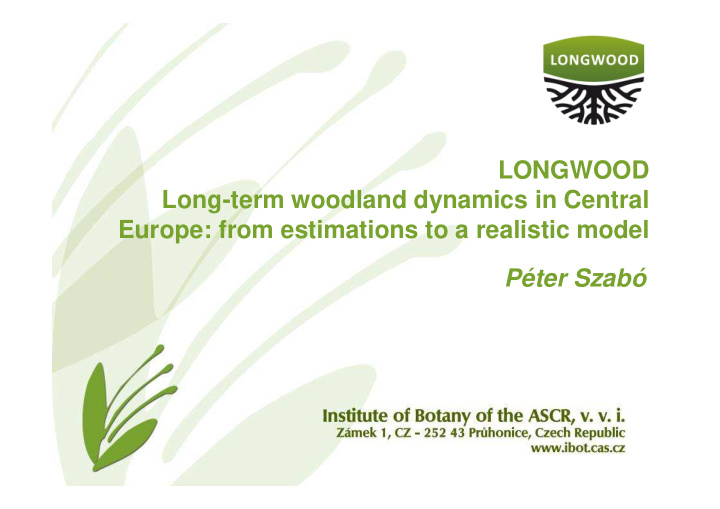



LONGWOOD Long-term woodland dynamics in Central Europe: from estimations to a realistic model Péter Szabó
Longwood About myself • Studied linguistics and history in Budapest • Specialization in the Middle Ages, PhD in interdisciplinary medieval studies at the Central European University (CEU) in Budapest • Research interest (woodland historical ecology) lies between history, archaeology and ecology • Institute of Botany of the Czech Academy of • Department of Medieval Archaeology at ELTE, Sciences, Brno, Czech Republic Budapest, Hungary
Longwood Disappearance and transformation of woodland since the Neolithic Several knowledge gaps: Two interconnected reasons: • Woodland cover until ca. AD 1800 is inferred • Lack of interdisciplinary cooperation from population density • Differences in scaling and resolution • Effects of traditional management on tree species composition are little known • Focus has been on trees, but herbaceous vegetation is key to biodiversity Szabó, Péter and Radim Hédl. "Advancing the integration of history and ecology for conservation." Conservation Biology 25 (2011): 680-687.
Longwood Aims • to combine historical, palaeoecological, vegetation ecological and archaeological data in GIS • to build a complex model of woodland dynamics for the past 8000 years in a well-defined, larger study region (Moravia) with the highest resolution possible • to relate past patterns in the tree layer to patterns in the herb layer • to analyze the role of humans in woodland dynamics • to provide material to improve forest management and nature conservation policies
Longwood Research team History & archaeology: Péter Szabó Palaeoecology: Petr Kuneš Vegetation ecology: Radim Hédl GIS: Jana Müllerová • young team: average age 35 yrs • balanced gender structure: 44% women, 56 % men
Longwood Results so far (more at www.longwood.cz) Papers: 13 (11 with IF) Conference presentations & posters: 29 (23 international)
Longwood Preparation Help from peers Interdisciplinary project – fairly long preparation process idea from me → general outline by working group leaders → individual parts → detailed research plan → feedback from all involved → updating → final version Simultaneously: technical details, budget preparation However: from the side of ERC straightforward and easy procedure!
Longwood Why (I think) we succeeded Key point : well thought out strategy (find out what makes you special and focus on that) Good CV is a must (first round evaluation) • unusual and interdisciplinary but watch out: • right time: need for interdisciplinary projects • it’s far from enough • good team, good institutional background • a good CV means a good CV in an • lot of effort put into presentation (interview international context crucial)
Longwood Novelty and potential • • Larger region - unprecedented amount of sources - Local studies – high resolution highest resolution possible Large-scale models – coarse resolution • In many senses our project is unique • Work intensive – the ERC provided a unique opportunity to realize our plan • Interdisciplinarity • high quality in all disciplines • synergetic results • Paradigm shift in ecology • Practical application: nature conservation and forestry
Longwood What helped me personally • postgraduate education in international environment and in English • good overview of general issues of interdisciplinarity • historical ecology is very much an upcoming discipline
Recommend
More recommend